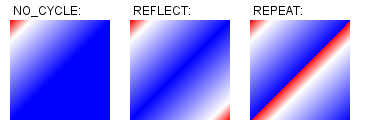Class LinearGradientPaint
- java.lang.Object
-
- java.awt.MultipleGradientPaint
-
- java.awt.LinearGradientPaint
-
- All Implemented Interfaces:
- Paint, Transparency
public final class LinearGradientPaint extends MultipleGradientPaintTheLinearGradientPaintclass provides a way to fill aShapewith a linear color gradient pattern. The user may specify two or more gradient colors, and this paint will provide an interpolation between each color. The user also specifies start and end points which define where in user space the color gradient should begin and end.The user must provide an array of floats specifying how to distribute the colors along the gradient. These values should range from 0.0 to 1.0 and act like keyframes along the gradient (they mark where the gradient should be exactly a particular color).
In the event that the user does not set the first keyframe value equal to 0 and/or the last keyframe value equal to 1, keyframes will be created at these positions and the first and last colors will be replicated there. So, if a user specifies the following arrays to construct a gradient:
{Color.BLUE, Color.RED}, {.3f, .7f}this will be converted to a gradient with the following keyframes:
{Color.BLUE, Color.BLUE, Color.RED, Color.RED}, {0f, .3f, .7f, 1f}The user may also select what action the
LinearGradientPaintobject takes when it is filling the space outside the start and end points by settingCycleMethodto eitherREFLECTIONorREPEAT. The distances between any two colors in any of the reflected or repeated copies of the gradient are the same as the distance between those same two colors between the start and end points. Note that some minor variations in distances may occur due to sampling at the granularity of a pixel. If no cycle method is specified,NO_CYCLEwill be chosen by default, which means the endpoint colors will be used to fill the remaining area.The colorSpace parameter allows the user to specify in which colorspace the interpolation should be performed, default sRGB or linearized RGB.
The following code demonstrates typical usage of
LinearGradientPaint:Point2D start = new Point2D.Float(0, 0); Point2D end = new Point2D.Float(50, 50); float[] dist = {0.0f, 0.2f, 1.0f}; Color[] colors = {Color.RED, Color.WHITE, Color.BLUE}; LinearGradientPaint p = new LinearGradientPaint(start, end, dist, colors);This code will create a
LinearGradientPaintwhich interpolates between red and white for the first 20% of the gradient and between white and blue for the remaining 80%.This image demonstrates the example code above for each of the three cycle methods:

- Since:
- 1.6
- See Also:
Paint,Graphics2D.setPaint(java.awt.Paint)
-
-
Nested Classes Modifier and Type Class and Description 
ColorSpaceType 
 The color space in which to perform the gradient interpolation.
The color space in which to perform the gradient interpolation.
CycleMethod 
 The method to use when painting outside the gradient bounds.
The method to use when painting outside the gradient bounds.
-
Fields Modifier and Type Field and Description 
BITMASK 
 Represents image data that is guaranteed to be either completely opaque, with an alpha value of 1.0, or completely transparent, with an alpha value of 0.0.
Represents image data that is guaranteed to be either completely opaque, with an alpha value of 1.0, or completely transparent, with an alpha value of 0.0.
OPAQUE 
 Represents image data that is guaranteed to be completely opaque, meaning that all pixels have an alpha value of 1.0.
Represents image data that is guaranteed to be completely opaque, meaning that all pixels have an alpha value of 1.0.
TRANSLUCENT 
 Represents image data that contains or might contain arbitrary alpha values between and including 0.0 and 1.0.
Represents image data that contains or might contain arbitrary alpha values between and including 0.0 and 1.0.
-
Methods Modifier and Type Method and Description 
createContext 
 Creates and returns a
Creates and returns aPaintContextused to generate a linear color gradient pattern.
getColors 
 Returns a copy of the array of colors used by this gradient.
Returns a copy of the array of colors used by this gradient.
getColorSpace 
 Returns the enumerated type which specifies color space for interpolation.
Returns the enumerated type which specifies color space for interpolation.
getCycleMethod 
 Returns the enumerated type which specifies cycling behavior.
Returns the enumerated type which specifies cycling behavior.
getEndPoint 
 Returns a copy of the end point of the gradient axis.
Returns a copy of the end point of the gradient axis.
getFractions 
 Returns a copy of the array of floats used by this gradient to calculate color distribution.
Returns a copy of the array of floats used by this gradient to calculate color distribution.
getStartPoint 
 Returns a copy of the start point of the gradient axis.
Returns a copy of the start point of the gradient axis.
getTransform 
 Returns a copy of the transform applied to the gradient.
Returns a copy of the transform applied to the gradient.
getTransparency 
 Returns the transparency mode for this
Returns the transparency mode for thisPaintobject.
-
